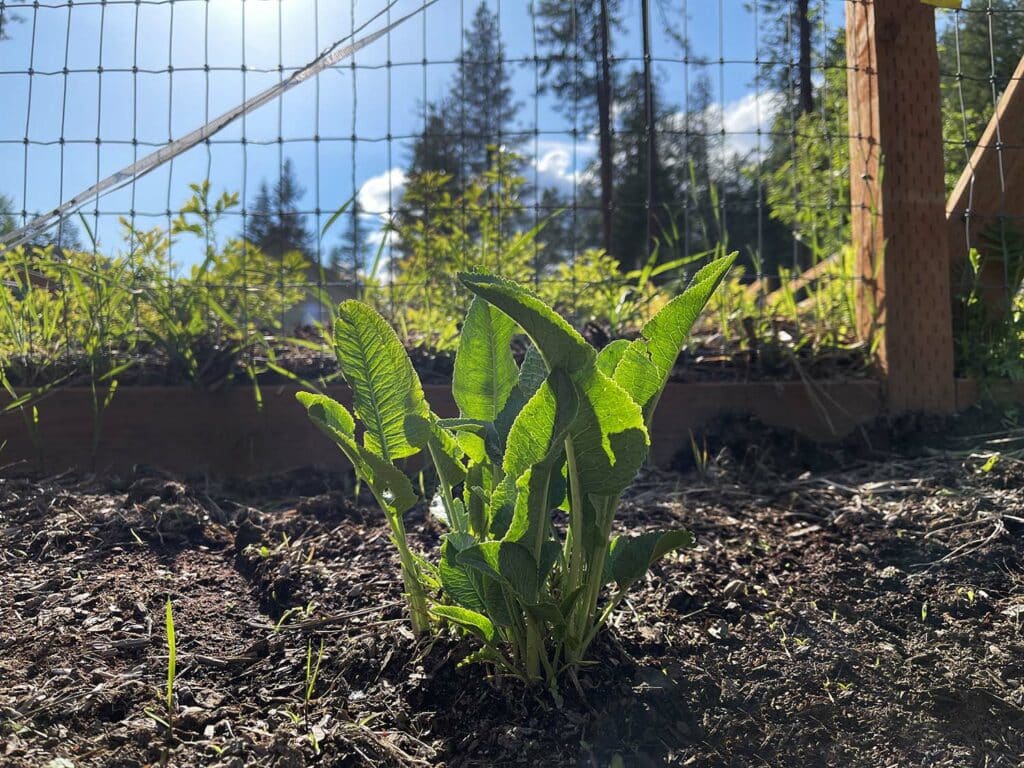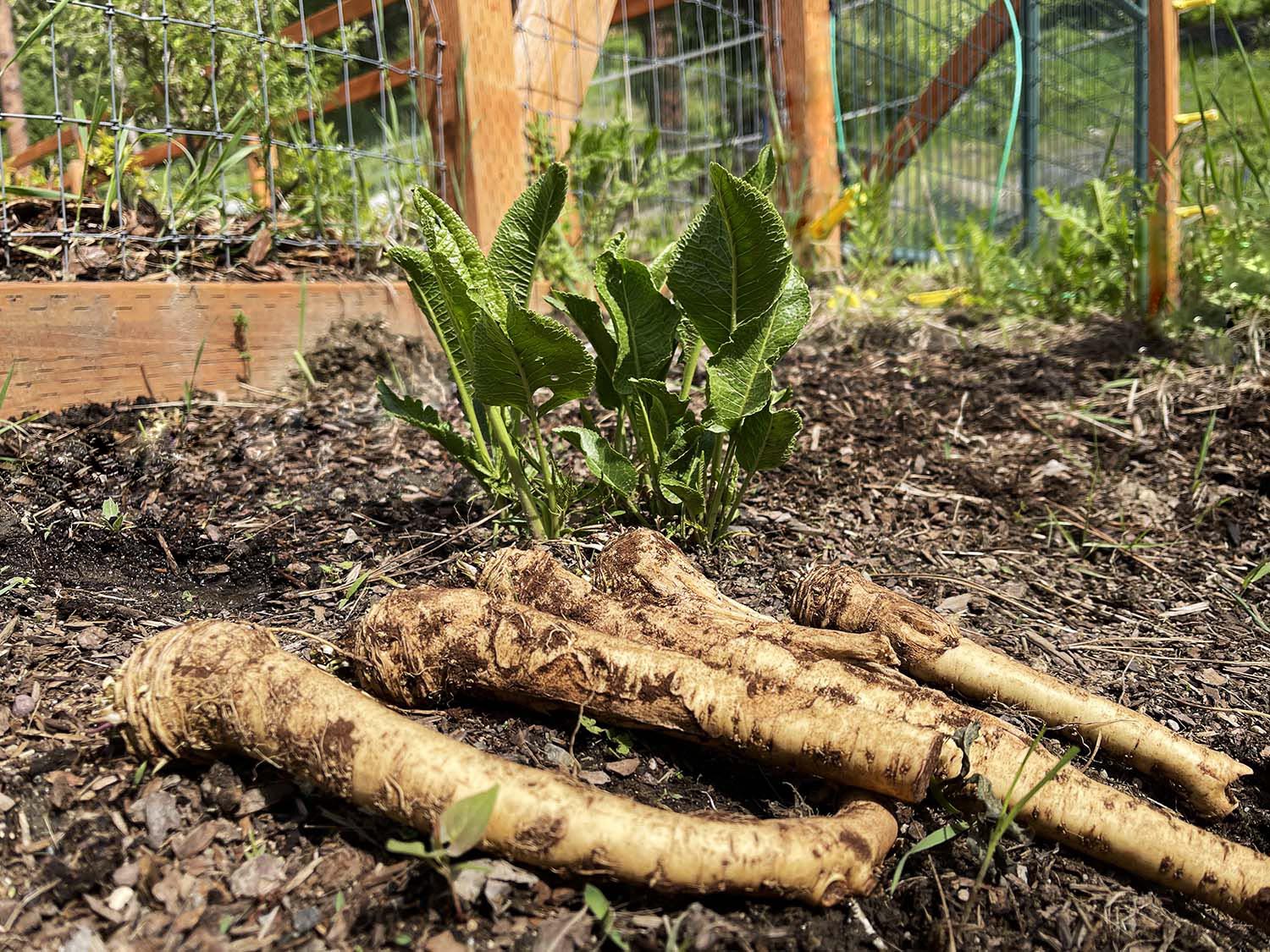Every year, I make a point of incorporating a couple of new perennial plants into my gardens. Perennial fruits, herbs and vegetables are a lazy gardener’s dream — plant once and with minimal maintenance, you can reap the rewards year after year.
This year, we’re adding Armoracia rusticana, aka horseradish.
Horseradish is a member of the Brassicaceae family, which also includes broccoli, kale, cauliflower and mustard. A hardy and easy-to-grow perennial, horseradish can adapt to almost any soil type and climate. Its USDA hardiness zones are usually listed as 3 to 9. It’s well suited to withstand extremely cold temperatures typical of zone 3, and can also thrive in milder regions up to zone 9, so long as measures are taken to protect the plants from excessive heat and ensure they receive adequate moisture.
At first encounter, horseradish’s intense spiciness might seem overwhelming, but with repeated exposure, its complex flavors can be truly appreciated. The initial heat gives way to a slightly sweet and tangy undertone, adding depth and character to dishes. Its sharpness can be invigorating and add a lovely ‘kick’ to a variety of culinary creations.
Horseradish tends to have a “love it or hate it” reputation, but for those willing to embrace its bold flavors, it’s an acquired taste worth acquiring!
Traditional uses
The origins of cooking with the pungent root date back centuries and can most likely be traced to Eastern European countries like Poland, Russia and Ukraine. Since it’s notoriously difficult to keep a great idea to yourself, by the 16th century, horseradish had made its way to Western Europe and by the 1800s, European immigrants had introduced it to the United States.
In German folklore, horseradish was often considered a powerful and protective plant. It was believed that planting horseradish in one’s garden would ward off evil spirits and bring good fortune to the household. People would often place horseradish roots under their beds or hang them on their doors to safeguard against malevolent forces and ill intentions.
Horseradish is a staple in Jewish cuisine and is commonly used during Passover as part of the Seder meal, served alongside matzo and other traditional foods.
Horseradish is also an important part of traditional German cuisine, served alongside sausages, roast meats and liverwurst. A horseradish sauce known as Meerrettichsoße is a popular accompaniment to these dishes.
Side note: I’ve probably listened to a dozen audio clips of “Meerrettichsoße” being spoken, and I still can’t pronounce it.
More than a condiment
Long before it was a condiment, though, horseradish was used medicinally.
The root of the horseradish plant contains compounds with anti-inflammatory, antibacterial and anti-cancer properties. It’s also been used as a natural diuretic and to stimulate the digestive system to relieve constipation and bloating.
Traditionally, horseradish was used to treat respiratory infections, including bronchitis, sinusitis and pneumonia. This is largely thanks to its constituent sinigrin, a sulfur-containing compound that’s responsible for horseradish’s (and mustard’s and wasabi’s) pungent taste and aroma.
When crushed or chewed, horseradish releases an enzyme called myrosinase that converts sinigrin into allyl isothiocyanate (AITC), which is thought to have anti-inflammatory and antibacterial properties. Studies suggest that AITC has the potential to inhibit the growth of bacteria such as E. coli, Salmonella enterica and Staphylococcus aureus. AITC’s anti-inflammatory effects may also be useful in the management of conditions such as arthritis, asthma and inflammatory bowel disease.
Horseradish also contains sulfur-containing compounds called glucosinolates, which are believed to have anti-cancer properties. One specific glucosinolate found in horseradish, called gluconasturtiin, has been shown to have anti-cancer effects in animal studies. It works by activating enzymes in the liver that help to detoxify carcinogens and other harmful substances. Horseradish also contains the flavonoid Kaempferol, which has been found to inhibit the growth and spread of cancer cells.
Growing horseradish
The best time to plant horseradish is in the early spring. While fall planting is also an option, spring planting is typically favored due to the favorable soil temperatures, minimized frost risk and optimal growing conditions. Wait until the soil reaches 50-60° F (10-15° C) for optimal root growth and establishment.
Look for a spot in your garden that receives full sun and has well-draining soil. Take care to choose a location with plenty of room for spreading. Horseradish primarily spreads through its root system, which can grow vigorously and give rise to a colony of new plants. The plant’s underground rhizomes, which are modified stems, send out lateral roots that can extend horizontally and give rise to new shoots. Horseradish can become invasive if left unchecked.
Prepare the soil by loosening it to a depth of at least 12″ and adding compost or well-rotted manure. Horseradish will grow in poor quality soil, but it grows best in rich, moist loamy soil. Dig a trench that is about 6″ deep and plant the horseradish root cuttings about 18 inches apart, with the top of the root cutting roughly 2″ below the soil surface. Once planted, make sure to keep the soil moist and free of weeds.
Troubleshooting tips
While horseradish is generally a hardy plant, you may run into some common issues.
Insufficient growth or weak plants:
- Horseradish thrives in full sun. Make sure the plants receive at least 6-8 hours of direct sunlight each day.
- Provide consistent moisture to the plants, especially during dry spells. Avoid overwatering, as it can lead to root rot.
- Ensure your horseradish is planted in well-draining soil that is rich in organic matter. Consider adding compost or well-balanced fertilizer to provide necessary nutrients.
Pests and diseases:
- Monitor your plants regularly for common pests like flea beetles, aphids and root maggots. Use organic pest control methods such as insecticidal soaps or neem oil if necessary.
- Maintain good airflow around the plants and avoid overcrowding to reduce the risk of fungal diseases. Remove any infected leaves or plants promptly to prevent the spread of diseases.
Weeds and competition:
- Keep the area around your horseradish plants weed-free to minimize competition for nutrients, water, and sunlight. Mulching can help suppress weeds and retain soil moisture.
- Ensure that horseradish plants have enough space to grow without overcrowding. Adequate spacing allows for better air circulation and reduces the risk of disease.
Winter protection:
- Apply a layer of mulch around the base of your horseradish plants before winter to help insulate the roots and protect them from freezing temperatures.
- Ensure that your horseradish roots are deep enough in the soil to withstand freezing temperatures. Planting them at least 6″ deep helps protect against winter damage.
Pest proof?
Horseradish is generally considered to be pest resistant. Those anti-cancer glucosinolates that give the plant its signature pungent smell and taste also act as an excellent natural pest deterrent, repelling many insects (as well as certain people).
However, no plant is completely immune to pests, and horseradish can still fall prey to some common garden pests big and small. Keeping your plants healthy and vigorous is the best way to keep pests such as flea beetles and aphids at bay. Provide your horseradish nutrient-rich soil, plenty of sunlight and water, but make sure to keep the soil well-drained. Avoid planting horseradish in areas that are prone to standing water, since this is how you end up with root maggots.
Here in North Idaho, you simply cannot garden without a proper fence. Deer, moose, bears, rabbits, ground squirrels and voles will wipe out your hard work in short order unless you can adequately protect it. I had high hopes that horseradish would be one crop I could grow outside the fence, since fenced garden space is a precious commodity that I’m forever trying to maximize. We have a number of deer who like to graze around the garden perimeter and would not be shy about helping themselves to vegetables, fruits and ornamental plants within their reach, but what about horseradish?
Unfortunately, this also includes horseradish leaves.
Someone once told me that there’s no such thing as a “deer proof” plant. “Deer proof” just means that the plant probably won’t die when the deer inevitably eat it. 🤣
It’s true — deer eat just about everything. Even things they don’t like will probably be sampled once of twice. Multiply that times a couple dozen deer in the vicinity of my garden, and… you get the picture. They’re not typically known to go after the root, though, so unless the leaves are just completely decimated before the horseradish has a chance to get established, you should be okay. If I can protect my root cuttings reasonably well until they establish themselves, it won’t be a huge deal if the odd deer with a penchant for spicy food nibbles on my horseradish leaves.
So after much deliberation, I decided to plant my horseradish outside the fence. Wish me luck!

Harvesting horseradish
Horseradish roots are typically ready for harvest after one growing season, around 8-10 months after planting. While you *could* harvest in the fall after the first frost, it’s better to wait until spring for a couple of reasons. First, horseradish roots tend to have the best flavor and quality when harvested in the spring. The cooler temperatures and adequate moisture during the spring season contribute to the development of crisp, flavorful roots. Spring is also an ideal time to replant the smaller roots to propagate your perennial horseradish patch.
To harvest, carefully dig up the plant, taking care not to damage the roots. Separate the larger, mature roots from the smaller ones, which can be replanted for further propagation. Trim the leaves and stems, leaving about an inch above the crown and store in a cool, dark place.
By replanting your smaller roots immediately after harvest, you allow the plant to continue its growth cycle (virtually) uninterrupted. The process of digging up and dividing the roots also helps to rejuvenate your horseradish plant(s), prevent overcrowding and promote healthy growth.
Bonus: Young horseradish greens are edible and have a sharp, slightly bitter flavor similar to mustard greens. Use them sparingly in salads, sautéed or added to soups and stews.
The keyword here is sparingly. As a general guideline, it’s best to harvest no more than 1/3 of the plant’s leaves at a time. This allows the horseradish plant to maintain sufficient foliage for continued growth and energy production.
Double bonus: When fermenting pickles or other vegetables, add a horseradish leaf to the fermentation vessel to help maintain the crunchiness of the vegetables during the fermentation process. The natural tannins in the leaf act as a natural preservative and help to keep the vegetables firm and crisp!
Have you grown horseradish in your garden? Tell us about it in the comments!



